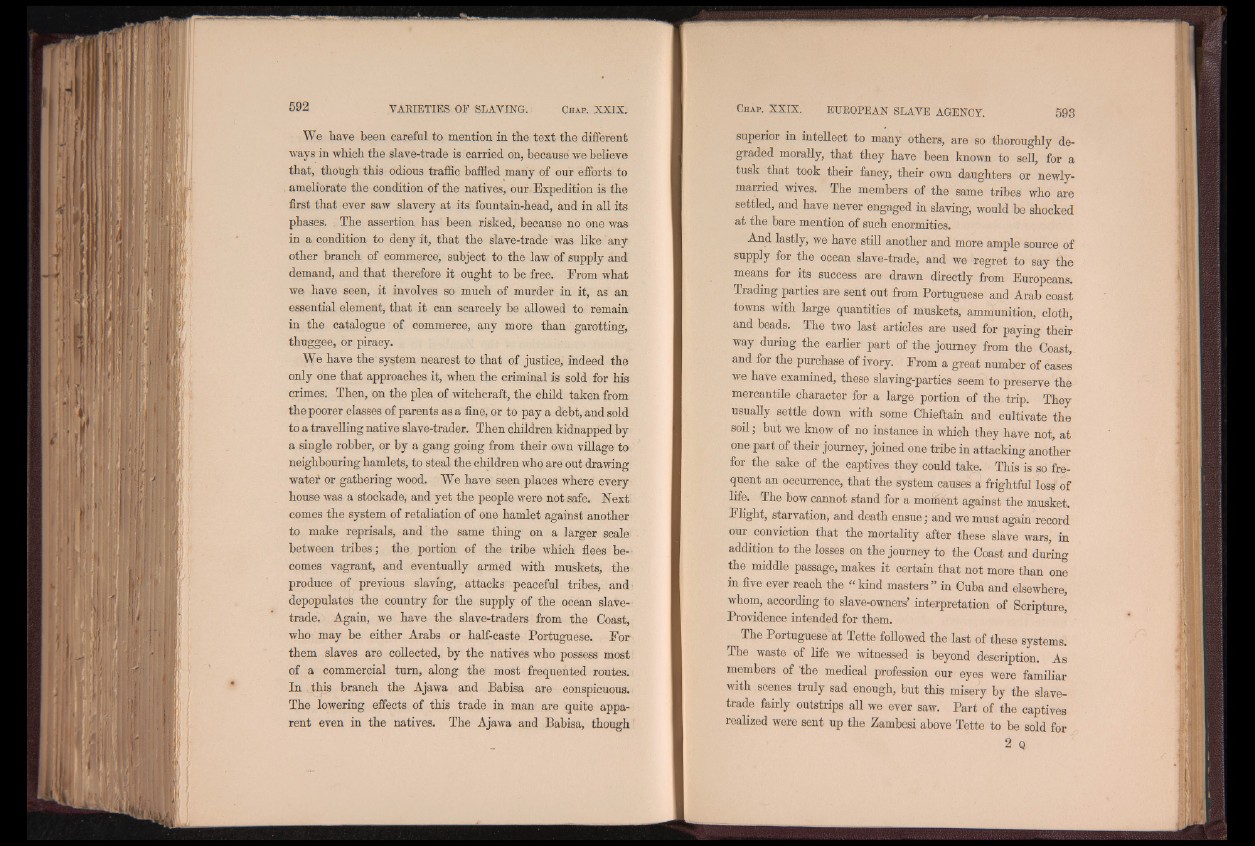
We have been careful to mention in the text the. different
ways in which the slave-trade is carried on, because we believe
that, though this odious traffic baffled many of our efforts to
ameliorate the condition of the natives, our Expedition is the
first that ever saw slavery at its fountain-head, and in all its
phases. The assertion has been risked, because no one was
in a condition to deny it, that the slave-trade was like any
other branch of commerce, subject to the law of supply and
demand, and that therefore it ought to be free. From what
we have seen, it involves so much of murder in it, as an
essential element, that it can scarcely be allowed to remain
in the catalogue of commerce, any more than garotting,
thuggee, or piracy.
We have the system nearest to that of justice, indeed the
only one that approaches it, when the criminal is sold for his
crimes. Then, on the plea of witchcraft, the child taken from
the poorer classes of parents as a fine, or to pay a debt, and sold
to a travelling native slave-trader. Then children kidnapped by
a single robber, or by a gang going from their own village to
neighbouring hamlets, to steal the children who are out drawing
watef or gathering wood. We have seen places where every
house was a stockade, and yet the people were not safe. Next
comes the system of retaliation of one hamlet against another
to make reprisals, and the same thing on a larger scale
between tribes; the portion of the tribe which flees becomes
vagrant, and eventually armed with muskets, the
produce of previous slaving, attacks peaceful tribes, and
depopulates the country for the supply of the ocean slave-
trade. Again, we have the slave-traders from the Coast,
who may be either Arabs or half-caste Portuguese. For
them slaves are collected, by the natives who possess most
of a commercial turn, along the most frequented routes.
In this branch the Ajawa and Babisa are conspicuous.
The lowering effects of this trade in man are quite apparent
even in the natives. The Ajawa and Babisa, though
superior in intellect to many others, are so thoroughly degraded
morally, that they have been known to sell, for a
tusk that took their fancy, their own daughters or newly-
married wives. The members of the same tribes who are
settled, and have never engaged in slaving, would be shocked
at the bare mention of such enormities.
And lastly, we have still another and more ample source of
supply for the ocean slave-trade, and we regret to say the
means for its success are drawn directly from Europeans.
Trading parties are sent out from Portuguese and Arab coast
towns with large quantities of muskets, ammunition, cloth,
and beads. The two last articles are used for paying their
way during the earlier part of the journey from the Coast,
and for the purchase of ivory. From a great number of cases
we have examined, these slaving-parties seem to preserve the
mercantile character for a large portion of the . trip. They
usually settle down with some Chieftain and cultivate the
soil; but we know of no instance in which they have not, at
one part of their journey, joined one tribe in attacking another
for the sake of the captives they could take. This is so frequent
an occurrence,, that the system causes a frightful loss of
life. The bow cannot stand for a moment against the musket.
Flight, starvation, and death ensue; and we must again record
our conviction that the mortality after these slave wars, in
addition to the losses on the journey to the Coast and during
the middle passage, makes it certain that not more than one
in five ever reach the “ kind masters ” in Cuba and elsewhere,
whom, according to slave-owners’ interpretation of Scripture*
Providence intended for them.
The Portuguese at Tette followed the last of these systems.
The waste of life we witnessed is beyond description. As
members of the medical profession our eyes were fomilLi-
with scenes truly sad enough, but this misery by the slave-
trade fairly outstrips all we ever saw. Part of the captives
realized were sent up the Zambesi above Tette to be sold for
2 Q